University Report: Injury Prevention Intervention Strategies
VerifiedAdded on 2022/10/01
|9
|2571
|375
Report
AI Summary
This report focuses on injury prevention interventions, specifically addressing repetitive strain injuries (RSI), a global health concern impacting the working population. It defines overuse injuries, reviews relevant literature, and emphasizes the significance of effective prevention strategies. The report proposes a community-based intervention plan that utilizes the 6 E's of injury prevention: education, engineering modifications, enactment, evaluation, economic incentives, and empowerment. This plan includes awareness campaigns, technological tools, educational sessions, and software designed to promote healthy work environments. The report also addresses the evaluation of the intervention's effectiveness, acknowledging the challenges in assessing long-term impacts and potential ecological fallacies. The conclusion highlights the importance of preventing RSI to improve quality of life and advocates for community-based interventions to enforce safety behaviors and promote the adoption of safety devices. The report references various studies and resources to support its findings and recommendations, aiming to provide a comprehensive overview of injury prevention strategies.
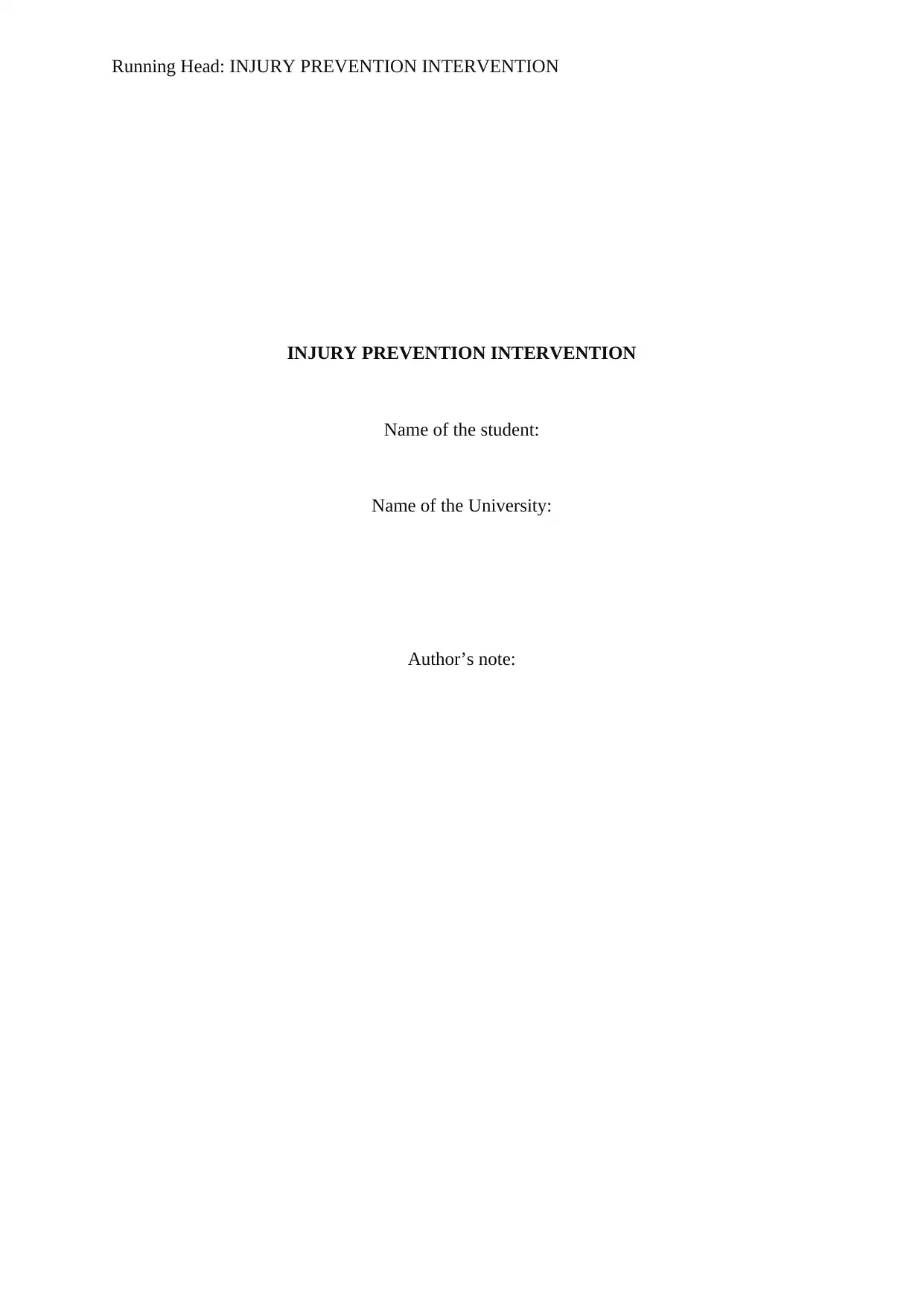
Running Head: INJURY PREVENTION INTERVENTION
INJURY PREVENTION INTERVENTION
Name of the student:
Name of the University:
Author’s note:
INJURY PREVENTION INTERVENTION
Name of the student:
Name of the University:
Author’s note:
Paraphrase This Document
Need a fresh take? Get an instant paraphrase of this document with our AI Paraphraser
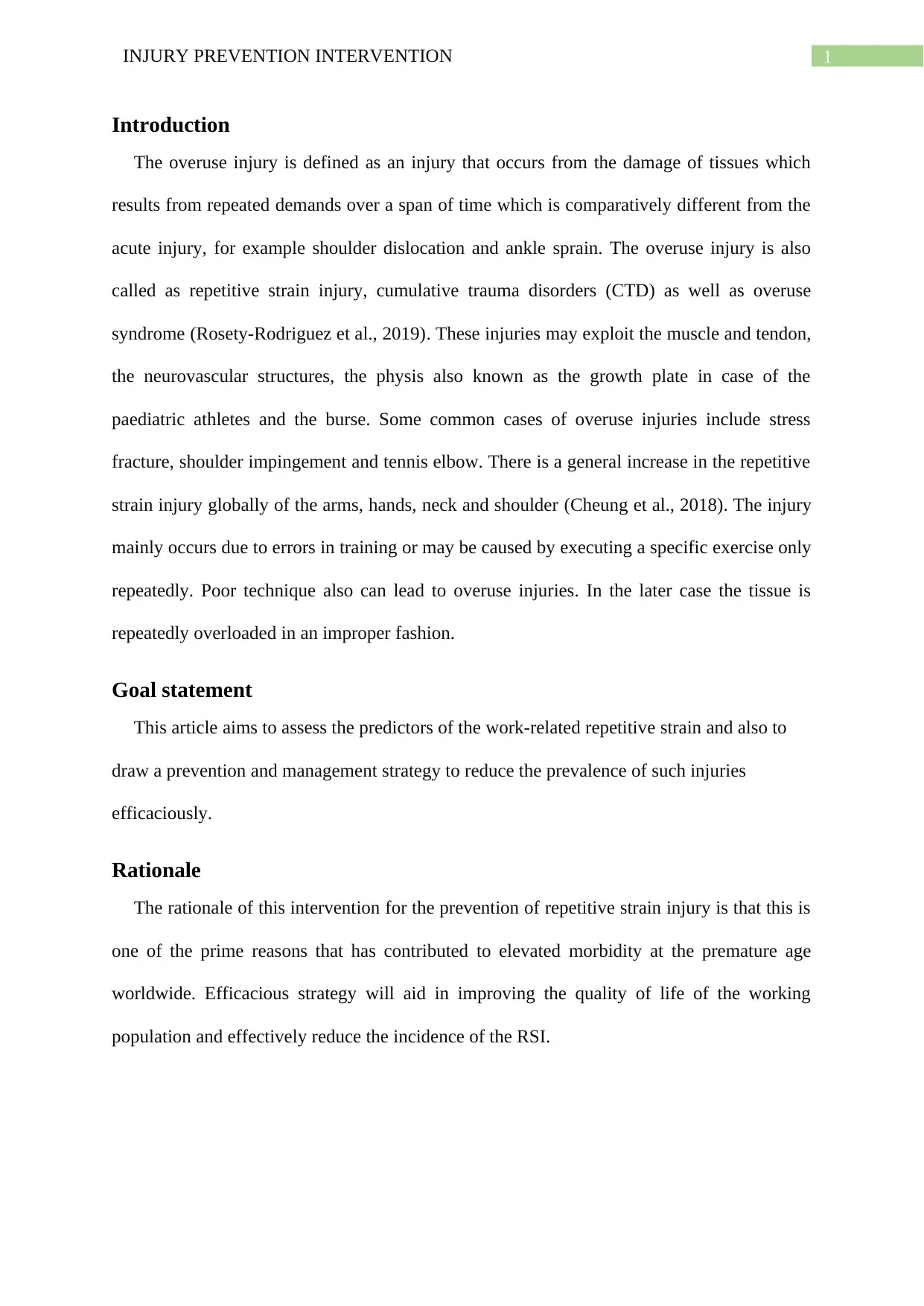
1INJURY PREVENTION INTERVENTION
Introduction
The overuse injury is defined as an injury that occurs from the damage of tissues which
results from repeated demands over a span of time which is comparatively different from the
acute injury, for example shoulder dislocation and ankle sprain. The overuse injury is also
called as repetitive strain injury, cumulative trauma disorders (CTD) as well as overuse
syndrome (Rosety-Rodriguez et al., 2019). These injuries may exploit the muscle and tendon,
the neurovascular structures, the physis also known as the growth plate in case of the
paediatric athletes and the burse. Some common cases of overuse injuries include stress
fracture, shoulder impingement and tennis elbow. There is a general increase in the repetitive
strain injury globally of the arms, hands, neck and shoulder (Cheung et al., 2018). The injury
mainly occurs due to errors in training or may be caused by executing a specific exercise only
repeatedly. Poor technique also can lead to overuse injuries. In the later case the tissue is
repeatedly overloaded in an improper fashion.
Goal statement
This article aims to assess the predictors of the work-related repetitive strain and also to
draw a prevention and management strategy to reduce the prevalence of such injuries
efficaciously.
Rationale
The rationale of this intervention for the prevention of repetitive strain injury is that this is
one of the prime reasons that has contributed to elevated morbidity at the premature age
worldwide. Efficacious strategy will aid in improving the quality of life of the working
population and effectively reduce the incidence of the RSI.
Introduction
The overuse injury is defined as an injury that occurs from the damage of tissues which
results from repeated demands over a span of time which is comparatively different from the
acute injury, for example shoulder dislocation and ankle sprain. The overuse injury is also
called as repetitive strain injury, cumulative trauma disorders (CTD) as well as overuse
syndrome (Rosety-Rodriguez et al., 2019). These injuries may exploit the muscle and tendon,
the neurovascular structures, the physis also known as the growth plate in case of the
paediatric athletes and the burse. Some common cases of overuse injuries include stress
fracture, shoulder impingement and tennis elbow. There is a general increase in the repetitive
strain injury globally of the arms, hands, neck and shoulder (Cheung et al., 2018). The injury
mainly occurs due to errors in training or may be caused by executing a specific exercise only
repeatedly. Poor technique also can lead to overuse injuries. In the later case the tissue is
repeatedly overloaded in an improper fashion.
Goal statement
This article aims to assess the predictors of the work-related repetitive strain and also to
draw a prevention and management strategy to reduce the prevalence of such injuries
efficaciously.
Rationale
The rationale of this intervention for the prevention of repetitive strain injury is that this is
one of the prime reasons that has contributed to elevated morbidity at the premature age
worldwide. Efficacious strategy will aid in improving the quality of life of the working
population and effectively reduce the incidence of the RSI.
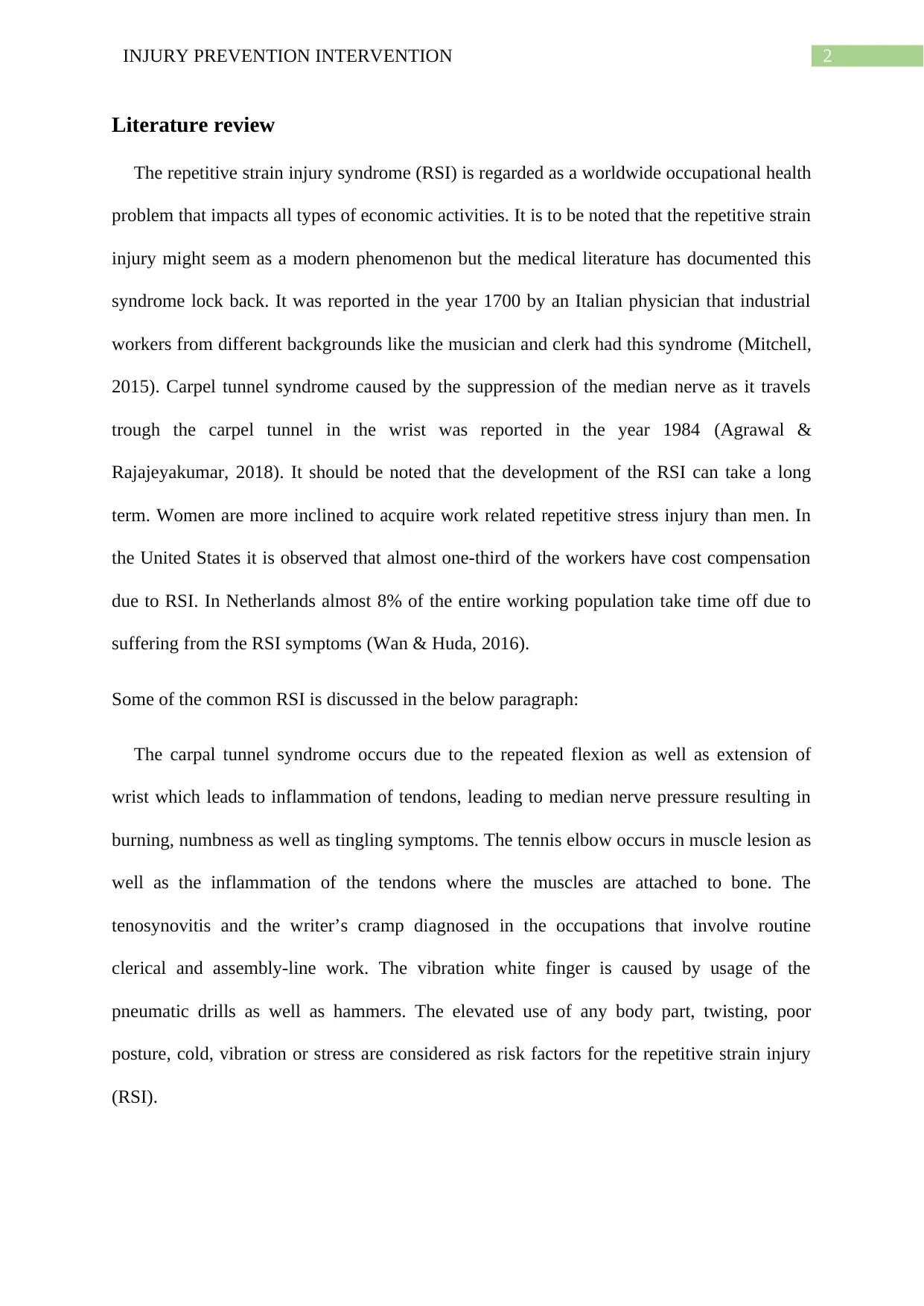
2INJURY PREVENTION INTERVENTION
Literature review
The repetitive strain injury syndrome (RSI) is regarded as a worldwide occupational health
problem that impacts all types of economic activities. It is to be noted that the repetitive strain
injury might seem as a modern phenomenon but the medical literature has documented this
syndrome lock back. It was reported in the year 1700 by an Italian physician that industrial
workers from different backgrounds like the musician and clerk had this syndrome (Mitchell,
2015). Carpel tunnel syndrome caused by the suppression of the median nerve as it travels
trough the carpel tunnel in the wrist was reported in the year 1984 (Agrawal &
Rajajeyakumar, 2018). It should be noted that the development of the RSI can take a long
term. Women are more inclined to acquire work related repetitive stress injury than men. In
the United States it is observed that almost one-third of the workers have cost compensation
due to RSI. In Netherlands almost 8% of the entire working population take time off due to
suffering from the RSI symptoms (Wan & Huda, 2016).
Some of the common RSI is discussed in the below paragraph:
The carpal tunnel syndrome occurs due to the repeated flexion as well as extension of
wrist which leads to inflammation of tendons, leading to median nerve pressure resulting in
burning, numbness as well as tingling symptoms. The tennis elbow occurs in muscle lesion as
well as the inflammation of the tendons where the muscles are attached to bone. The
tenosynovitis and the writer’s cramp diagnosed in the occupations that involve routine
clerical and assembly-line work. The vibration white finger is caused by usage of the
pneumatic drills as well as hammers. The elevated use of any body part, twisting, poor
posture, cold, vibration or stress are considered as risk factors for the repetitive strain injury
(RSI).
Literature review
The repetitive strain injury syndrome (RSI) is regarded as a worldwide occupational health
problem that impacts all types of economic activities. It is to be noted that the repetitive strain
injury might seem as a modern phenomenon but the medical literature has documented this
syndrome lock back. It was reported in the year 1700 by an Italian physician that industrial
workers from different backgrounds like the musician and clerk had this syndrome (Mitchell,
2015). Carpel tunnel syndrome caused by the suppression of the median nerve as it travels
trough the carpel tunnel in the wrist was reported in the year 1984 (Agrawal &
Rajajeyakumar, 2018). It should be noted that the development of the RSI can take a long
term. Women are more inclined to acquire work related repetitive stress injury than men. In
the United States it is observed that almost one-third of the workers have cost compensation
due to RSI. In Netherlands almost 8% of the entire working population take time off due to
suffering from the RSI symptoms (Wan & Huda, 2016).
Some of the common RSI is discussed in the below paragraph:
The carpal tunnel syndrome occurs due to the repeated flexion as well as extension of
wrist which leads to inflammation of tendons, leading to median nerve pressure resulting in
burning, numbness as well as tingling symptoms. The tennis elbow occurs in muscle lesion as
well as the inflammation of the tendons where the muscles are attached to bone. The
tenosynovitis and the writer’s cramp diagnosed in the occupations that involve routine
clerical and assembly-line work. The vibration white finger is caused by usage of the
pneumatic drills as well as hammers. The elevated use of any body part, twisting, poor
posture, cold, vibration or stress are considered as risk factors for the repetitive strain injury
(RSI).
⊘ This is a preview!⊘
Do you want full access?
Subscribe today to unlock all pages.

Trusted by 1+ million students worldwide
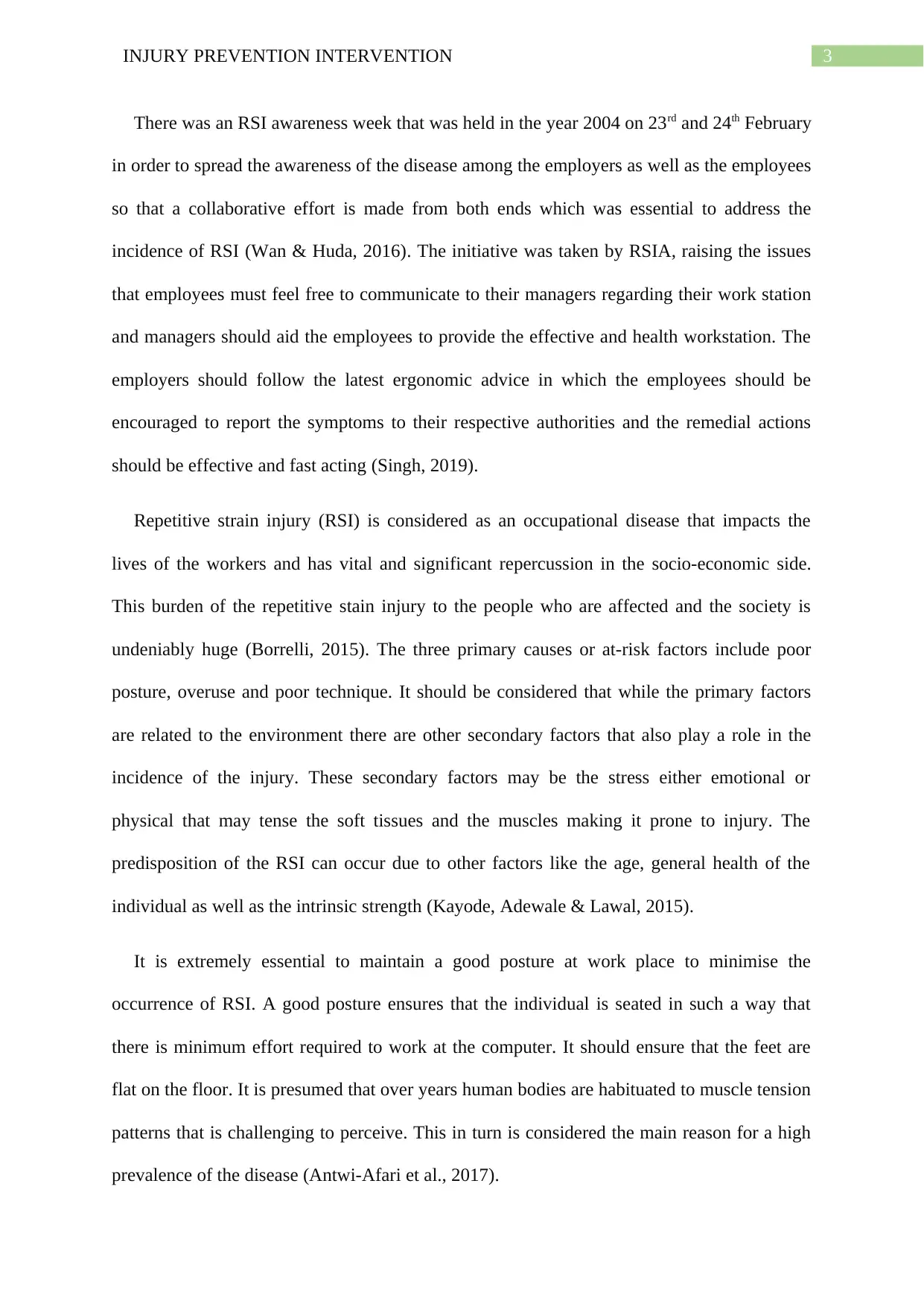
3INJURY PREVENTION INTERVENTION
There was an RSI awareness week that was held in the year 2004 on 23rd and 24th February
in order to spread the awareness of the disease among the employers as well as the employees
so that a collaborative effort is made from both ends which was essential to address the
incidence of RSI (Wan & Huda, 2016). The initiative was taken by RSIA, raising the issues
that employees must feel free to communicate to their managers regarding their work station
and managers should aid the employees to provide the effective and health workstation. The
employers should follow the latest ergonomic advice in which the employees should be
encouraged to report the symptoms to their respective authorities and the remedial actions
should be effective and fast acting (Singh, 2019).
Repetitive strain injury (RSI) is considered as an occupational disease that impacts the
lives of the workers and has vital and significant repercussion in the socio-economic side.
This burden of the repetitive stain injury to the people who are affected and the society is
undeniably huge (Borrelli, 2015). The three primary causes or at-risk factors include poor
posture, overuse and poor technique. It should be considered that while the primary factors
are related to the environment there are other secondary factors that also play a role in the
incidence of the injury. These secondary factors may be the stress either emotional or
physical that may tense the soft tissues and the muscles making it prone to injury. The
predisposition of the RSI can occur due to other factors like the age, general health of the
individual as well as the intrinsic strength (Kayode, Adewale & Lawal, 2015).
It is extremely essential to maintain a good posture at work place to minimise the
occurrence of RSI. A good posture ensures that the individual is seated in such a way that
there is minimum effort required to work at the computer. It should ensure that the feet are
flat on the floor. It is presumed that over years human bodies are habituated to muscle tension
patterns that is challenging to perceive. This in turn is considered the main reason for a high
prevalence of the disease (Antwi-Afari et al., 2017).
There was an RSI awareness week that was held in the year 2004 on 23rd and 24th February
in order to spread the awareness of the disease among the employers as well as the employees
so that a collaborative effort is made from both ends which was essential to address the
incidence of RSI (Wan & Huda, 2016). The initiative was taken by RSIA, raising the issues
that employees must feel free to communicate to their managers regarding their work station
and managers should aid the employees to provide the effective and health workstation. The
employers should follow the latest ergonomic advice in which the employees should be
encouraged to report the symptoms to their respective authorities and the remedial actions
should be effective and fast acting (Singh, 2019).
Repetitive strain injury (RSI) is considered as an occupational disease that impacts the
lives of the workers and has vital and significant repercussion in the socio-economic side.
This burden of the repetitive stain injury to the people who are affected and the society is
undeniably huge (Borrelli, 2015). The three primary causes or at-risk factors include poor
posture, overuse and poor technique. It should be considered that while the primary factors
are related to the environment there are other secondary factors that also play a role in the
incidence of the injury. These secondary factors may be the stress either emotional or
physical that may tense the soft tissues and the muscles making it prone to injury. The
predisposition of the RSI can occur due to other factors like the age, general health of the
individual as well as the intrinsic strength (Kayode, Adewale & Lawal, 2015).
It is extremely essential to maintain a good posture at work place to minimise the
occurrence of RSI. A good posture ensures that the individual is seated in such a way that
there is minimum effort required to work at the computer. It should ensure that the feet are
flat on the floor. It is presumed that over years human bodies are habituated to muscle tension
patterns that is challenging to perceive. This in turn is considered the main reason for a high
prevalence of the disease (Antwi-Afari et al., 2017).
Paraphrase This Document
Need a fresh take? Get an instant paraphrase of this document with our AI Paraphraser
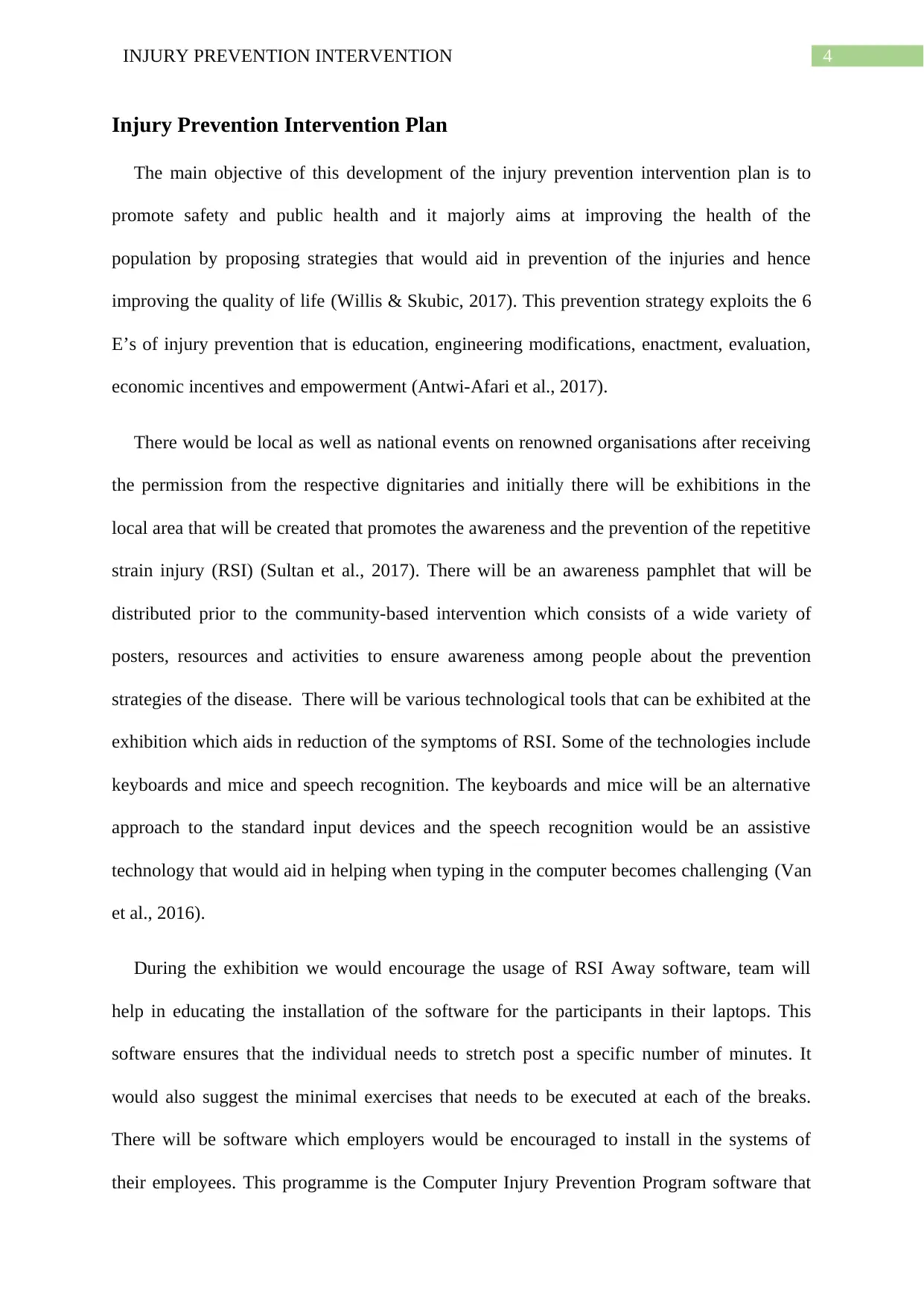
4INJURY PREVENTION INTERVENTION
Injury Prevention Intervention Plan
The main objective of this development of the injury prevention intervention plan is to
promote safety and public health and it majorly aims at improving the health of the
population by proposing strategies that would aid in prevention of the injuries and hence
improving the quality of life (Willis & Skubic, 2017). This prevention strategy exploits the 6
E’s of injury prevention that is education, engineering modifications, enactment, evaluation,
economic incentives and empowerment (Antwi-Afari et al., 2017).
There would be local as well as national events on renowned organisations after receiving
the permission from the respective dignitaries and initially there will be exhibitions in the
local area that will be created that promotes the awareness and the prevention of the repetitive
strain injury (RSI) (Sultan et al., 2017). There will be an awareness pamphlet that will be
distributed prior to the community-based intervention which consists of a wide variety of
posters, resources and activities to ensure awareness among people about the prevention
strategies of the disease. There will be various technological tools that can be exhibited at the
exhibition which aids in reduction of the symptoms of RSI. Some of the technologies include
keyboards and mice and speech recognition. The keyboards and mice will be an alternative
approach to the standard input devices and the speech recognition would be an assistive
technology that would aid in helping when typing in the computer becomes challenging (Van
et al., 2016).
During the exhibition we would encourage the usage of RSI Away software, team will
help in educating the installation of the software for the participants in their laptops. This
software ensures that the individual needs to stretch post a specific number of minutes. It
would also suggest the minimal exercises that needs to be executed at each of the breaks.
There will be software which employers would be encouraged to install in the systems of
their employees. This programme is the Computer Injury Prevention Program software that
Injury Prevention Intervention Plan
The main objective of this development of the injury prevention intervention plan is to
promote safety and public health and it majorly aims at improving the health of the
population by proposing strategies that would aid in prevention of the injuries and hence
improving the quality of life (Willis & Skubic, 2017). This prevention strategy exploits the 6
E’s of injury prevention that is education, engineering modifications, enactment, evaluation,
economic incentives and empowerment (Antwi-Afari et al., 2017).
There would be local as well as national events on renowned organisations after receiving
the permission from the respective dignitaries and initially there will be exhibitions in the
local area that will be created that promotes the awareness and the prevention of the repetitive
strain injury (RSI) (Sultan et al., 2017). There will be an awareness pamphlet that will be
distributed prior to the community-based intervention which consists of a wide variety of
posters, resources and activities to ensure awareness among people about the prevention
strategies of the disease. There will be various technological tools that can be exhibited at the
exhibition which aids in reduction of the symptoms of RSI. Some of the technologies include
keyboards and mice and speech recognition. The keyboards and mice will be an alternative
approach to the standard input devices and the speech recognition would be an assistive
technology that would aid in helping when typing in the computer becomes challenging (Van
et al., 2016).
During the exhibition we would encourage the usage of RSI Away software, team will
help in educating the installation of the software for the participants in their laptops. This
software ensures that the individual needs to stretch post a specific number of minutes. It
would also suggest the minimal exercises that needs to be executed at each of the breaks.
There will be software which employers would be encouraged to install in the systems of
their employees. This programme is the Computer Injury Prevention Program software that
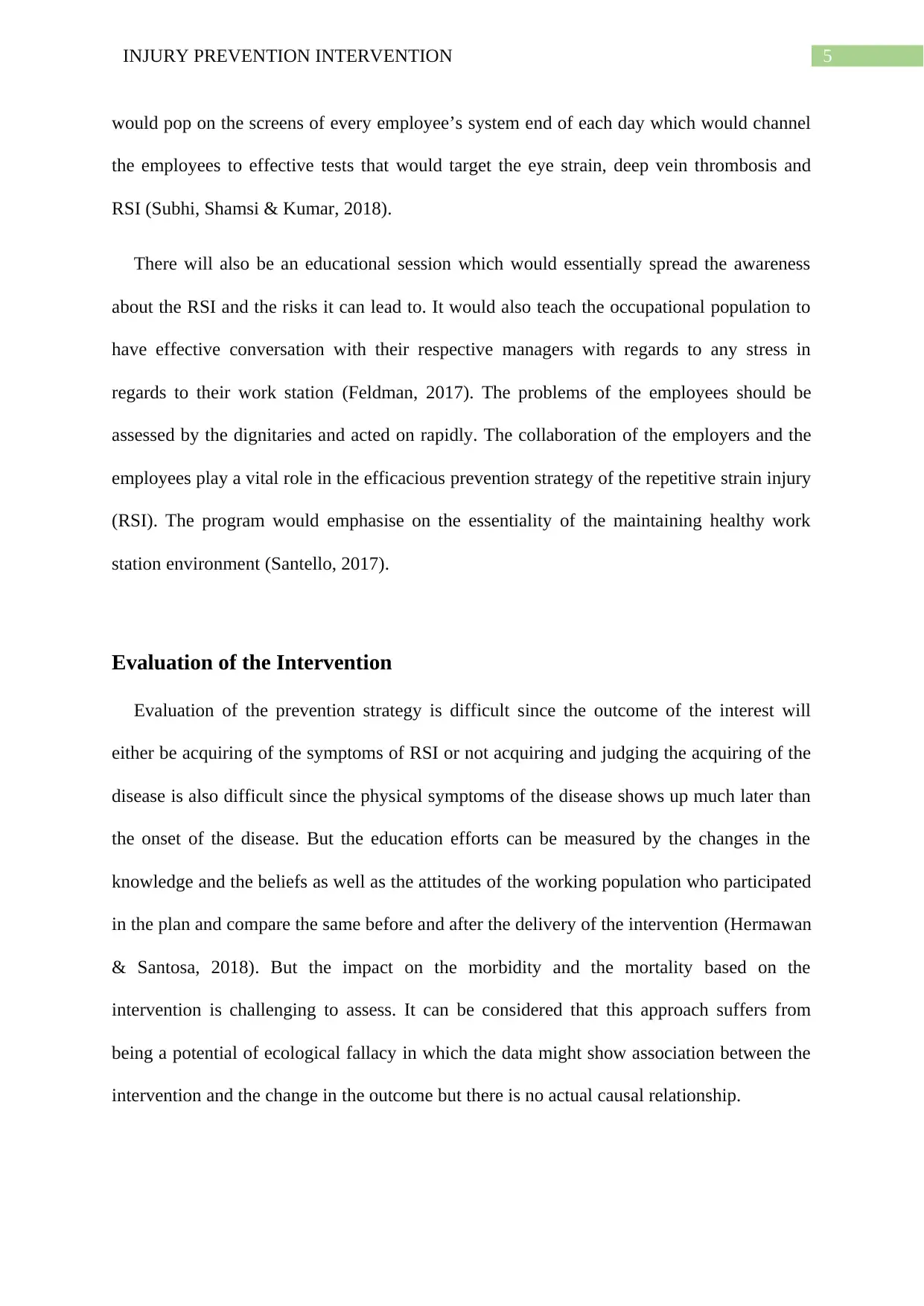
5INJURY PREVENTION INTERVENTION
would pop on the screens of every employee’s system end of each day which would channel
the employees to effective tests that would target the eye strain, deep vein thrombosis and
RSI (Subhi, Shamsi & Kumar, 2018).
There will also be an educational session which would essentially spread the awareness
about the RSI and the risks it can lead to. It would also teach the occupational population to
have effective conversation with their respective managers with regards to any stress in
regards to their work station (Feldman, 2017). The problems of the employees should be
assessed by the dignitaries and acted on rapidly. The collaboration of the employers and the
employees play a vital role in the efficacious prevention strategy of the repetitive strain injury
(RSI). The program would emphasise on the essentiality of the maintaining healthy work
station environment (Santello, 2017).
Evaluation of the Intervention
Evaluation of the prevention strategy is difficult since the outcome of the interest will
either be acquiring of the symptoms of RSI or not acquiring and judging the acquiring of the
disease is also difficult since the physical symptoms of the disease shows up much later than
the onset of the disease. But the education efforts can be measured by the changes in the
knowledge and the beliefs as well as the attitudes of the working population who participated
in the plan and compare the same before and after the delivery of the intervention (Hermawan
& Santosa, 2018). But the impact on the morbidity and the mortality based on the
intervention is challenging to assess. It can be considered that this approach suffers from
being a potential of ecological fallacy in which the data might show association between the
intervention and the change in the outcome but there is no actual causal relationship.
would pop on the screens of every employee’s system end of each day which would channel
the employees to effective tests that would target the eye strain, deep vein thrombosis and
RSI (Subhi, Shamsi & Kumar, 2018).
There will also be an educational session which would essentially spread the awareness
about the RSI and the risks it can lead to. It would also teach the occupational population to
have effective conversation with their respective managers with regards to any stress in
regards to their work station (Feldman, 2017). The problems of the employees should be
assessed by the dignitaries and acted on rapidly. The collaboration of the employers and the
employees play a vital role in the efficacious prevention strategy of the repetitive strain injury
(RSI). The program would emphasise on the essentiality of the maintaining healthy work
station environment (Santello, 2017).
Evaluation of the Intervention
Evaluation of the prevention strategy is difficult since the outcome of the interest will
either be acquiring of the symptoms of RSI or not acquiring and judging the acquiring of the
disease is also difficult since the physical symptoms of the disease shows up much later than
the onset of the disease. But the education efforts can be measured by the changes in the
knowledge and the beliefs as well as the attitudes of the working population who participated
in the plan and compare the same before and after the delivery of the intervention (Hermawan
& Santosa, 2018). But the impact on the morbidity and the mortality based on the
intervention is challenging to assess. It can be considered that this approach suffers from
being a potential of ecological fallacy in which the data might show association between the
intervention and the change in the outcome but there is no actual causal relationship.
⊘ This is a preview!⊘
Do you want full access?
Subscribe today to unlock all pages.

Trusted by 1+ million students worldwide
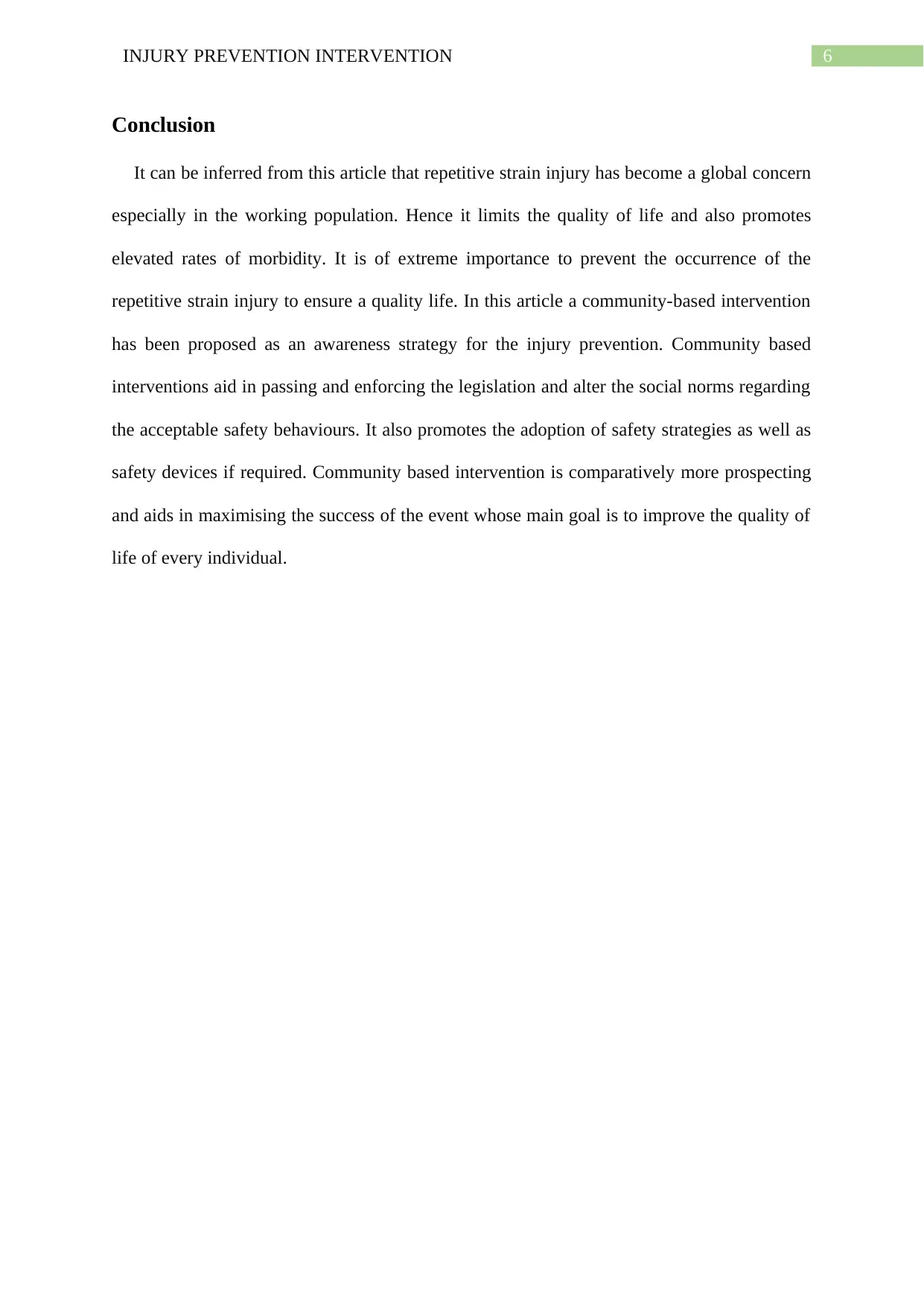
6INJURY PREVENTION INTERVENTION
Conclusion
It can be inferred from this article that repetitive strain injury has become a global concern
especially in the working population. Hence it limits the quality of life and also promotes
elevated rates of morbidity. It is of extreme importance to prevent the occurrence of the
repetitive strain injury to ensure a quality life. In this article a community-based intervention
has been proposed as an awareness strategy for the injury prevention. Community based
interventions aid in passing and enforcing the legislation and alter the social norms regarding
the acceptable safety behaviours. It also promotes the adoption of safety strategies as well as
safety devices if required. Community based intervention is comparatively more prospecting
and aids in maximising the success of the event whose main goal is to improve the quality of
life of every individual.
Conclusion
It can be inferred from this article that repetitive strain injury has become a global concern
especially in the working population. Hence it limits the quality of life and also promotes
elevated rates of morbidity. It is of extreme importance to prevent the occurrence of the
repetitive strain injury to ensure a quality life. In this article a community-based intervention
has been proposed as an awareness strategy for the injury prevention. Community based
interventions aid in passing and enforcing the legislation and alter the social norms regarding
the acceptable safety behaviours. It also promotes the adoption of safety strategies as well as
safety devices if required. Community based intervention is comparatively more prospecting
and aids in maximising the success of the event whose main goal is to improve the quality of
life of every individual.
Paraphrase This Document
Need a fresh take? Get an instant paraphrase of this document with our AI Paraphraser
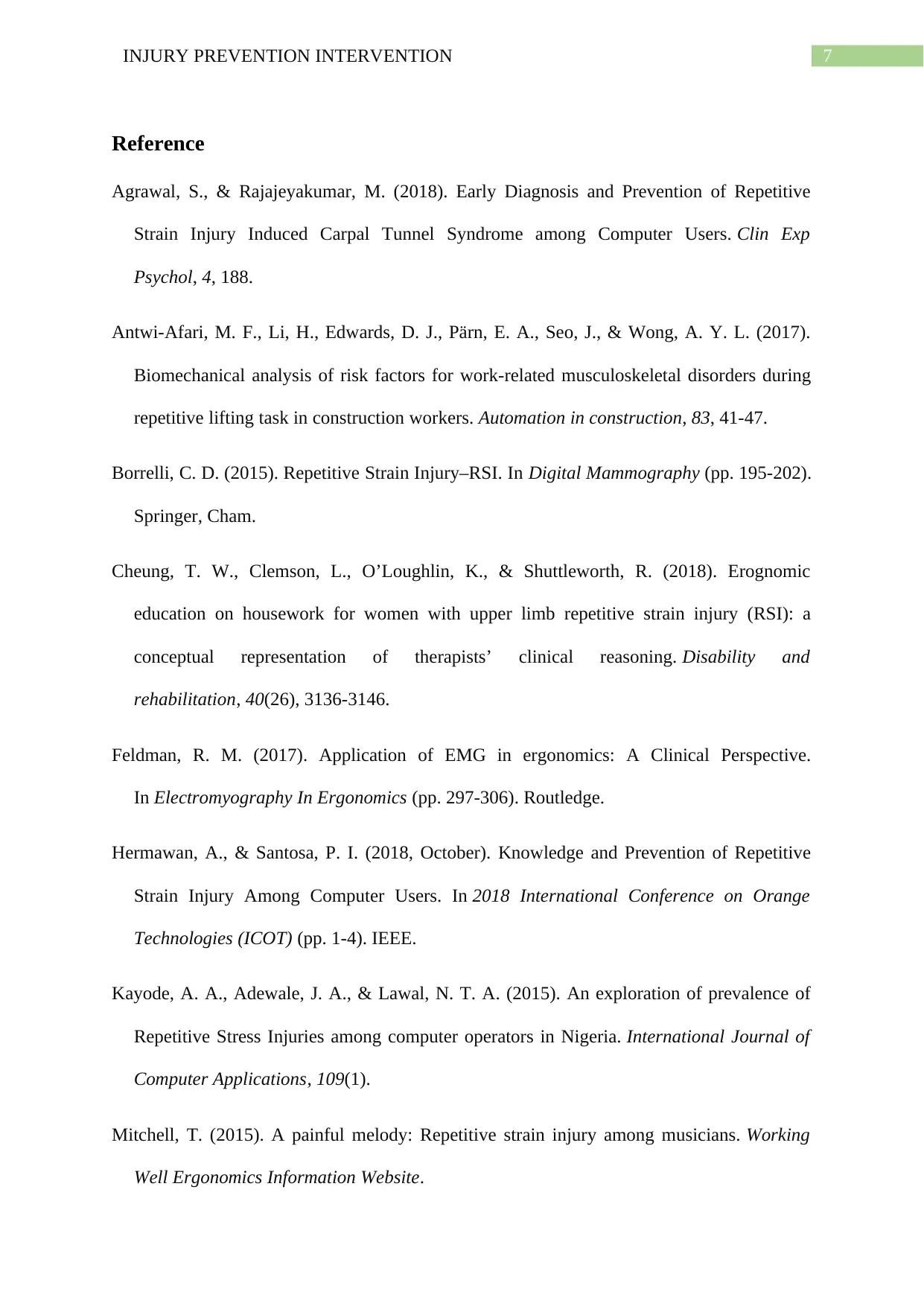
7INJURY PREVENTION INTERVENTION
Reference
Agrawal, S., & Rajajeyakumar, M. (2018). Early Diagnosis and Prevention of Repetitive
Strain Injury Induced Carpal Tunnel Syndrome among Computer Users. Clin Exp
Psychol, 4, 188.
Antwi-Afari, M. F., Li, H., Edwards, D. J., Pärn, E. A., Seo, J., & Wong, A. Y. L. (2017).
Biomechanical analysis of risk factors for work-related musculoskeletal disorders during
repetitive lifting task in construction workers. Automation in construction, 83, 41-47.
Borrelli, C. D. (2015). Repetitive Strain Injury–RSI. In Digital Mammography (pp. 195-202).
Springer, Cham.
Cheung, T. W., Clemson, L., O’Loughlin, K., & Shuttleworth, R. (2018). Erognomic
education on housework for women with upper limb repetitive strain injury (RSI): a
conceptual representation of therapists’ clinical reasoning. Disability and
rehabilitation, 40(26), 3136-3146.
Feldman, R. M. (2017). Application of EMG in ergonomics: A Clinical Perspective.
In Electromyography In Ergonomics (pp. 297-306). Routledge.
Hermawan, A., & Santosa, P. I. (2018, October). Knowledge and Prevention of Repetitive
Strain Injury Among Computer Users. In 2018 International Conference on Orange
Technologies (ICOT) (pp. 1-4). IEEE.
Kayode, A. A., Adewale, J. A., & Lawal, N. T. A. (2015). An exploration of prevalence of
Repetitive Stress Injuries among computer operators in Nigeria. International Journal of
Computer Applications, 109(1).
Mitchell, T. (2015). A painful melody: Repetitive strain injury among musicians. Working
Well Ergonomics Information Website.
Reference
Agrawal, S., & Rajajeyakumar, M. (2018). Early Diagnosis and Prevention of Repetitive
Strain Injury Induced Carpal Tunnel Syndrome among Computer Users. Clin Exp
Psychol, 4, 188.
Antwi-Afari, M. F., Li, H., Edwards, D. J., Pärn, E. A., Seo, J., & Wong, A. Y. L. (2017).
Biomechanical analysis of risk factors for work-related musculoskeletal disorders during
repetitive lifting task in construction workers. Automation in construction, 83, 41-47.
Borrelli, C. D. (2015). Repetitive Strain Injury–RSI. In Digital Mammography (pp. 195-202).
Springer, Cham.
Cheung, T. W., Clemson, L., O’Loughlin, K., & Shuttleworth, R. (2018). Erognomic
education on housework for women with upper limb repetitive strain injury (RSI): a
conceptual representation of therapists’ clinical reasoning. Disability and
rehabilitation, 40(26), 3136-3146.
Feldman, R. M. (2017). Application of EMG in ergonomics: A Clinical Perspective.
In Electromyography In Ergonomics (pp. 297-306). Routledge.
Hermawan, A., & Santosa, P. I. (2018, October). Knowledge and Prevention of Repetitive
Strain Injury Among Computer Users. In 2018 International Conference on Orange
Technologies (ICOT) (pp. 1-4). IEEE.
Kayode, A. A., Adewale, J. A., & Lawal, N. T. A. (2015). An exploration of prevalence of
Repetitive Stress Injuries among computer operators in Nigeria. International Journal of
Computer Applications, 109(1).
Mitchell, T. (2015). A painful melody: Repetitive strain injury among musicians. Working
Well Ergonomics Information Website.
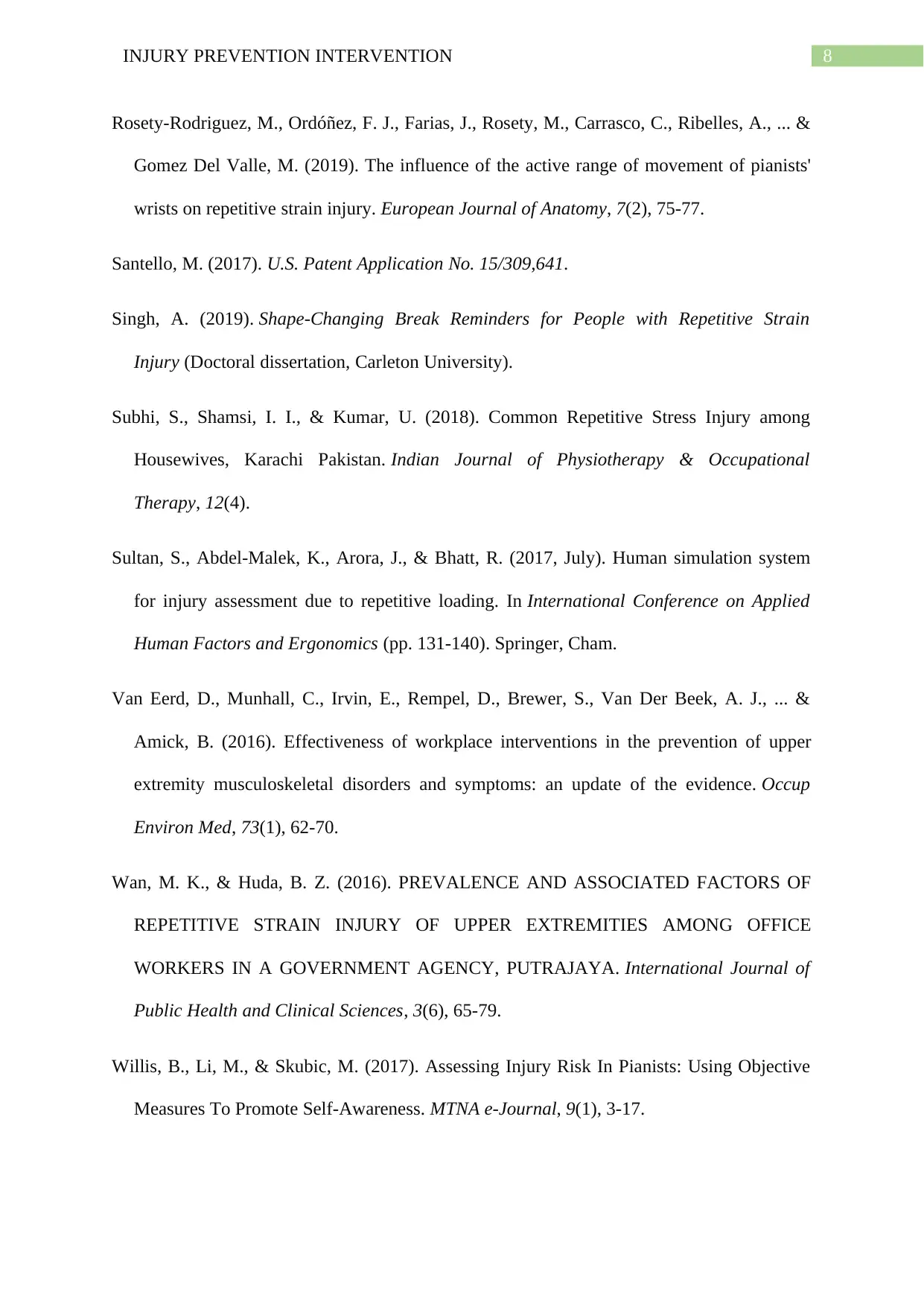
8INJURY PREVENTION INTERVENTION
Rosety-Rodriguez, M., Ordóñez, F. J., Farias, J., Rosety, M., Carrasco, C., Ribelles, A., ... &
Gomez Del Valle, M. (2019). The influence of the active range of movement of pianists'
wrists on repetitive strain injury. European Journal of Anatomy, 7(2), 75-77.
Santello, M. (2017). U.S. Patent Application No. 15/309,641.
Singh, A. (2019). Shape-Changing Break Reminders for People with Repetitive Strain
Injury (Doctoral dissertation, Carleton University).
Subhi, S., Shamsi, I. I., & Kumar, U. (2018). Common Repetitive Stress Injury among
Housewives, Karachi Pakistan. Indian Journal of Physiotherapy & Occupational
Therapy, 12(4).
Sultan, S., Abdel-Malek, K., Arora, J., & Bhatt, R. (2017, July). Human simulation system
for injury assessment due to repetitive loading. In International Conference on Applied
Human Factors and Ergonomics (pp. 131-140). Springer, Cham.
Van Eerd, D., Munhall, C., Irvin, E., Rempel, D., Brewer, S., Van Der Beek, A. J., ... &
Amick, B. (2016). Effectiveness of workplace interventions in the prevention of upper
extremity musculoskeletal disorders and symptoms: an update of the evidence. Occup
Environ Med, 73(1), 62-70.
Wan, M. K., & Huda, B. Z. (2016). PREVALENCE AND ASSOCIATED FACTORS OF
REPETITIVE STRAIN INJURY OF UPPER EXTREMITIES AMONG OFFICE
WORKERS IN A GOVERNMENT AGENCY, PUTRAJAYA. International Journal of
Public Health and Clinical Sciences, 3(6), 65-79.
Willis, B., Li, M., & Skubic, M. (2017). Assessing Injury Risk In Pianists: Using Objective
Measures To Promote Self-Awareness. MTNA e-Journal, 9(1), 3-17.
Rosety-Rodriguez, M., Ordóñez, F. J., Farias, J., Rosety, M., Carrasco, C., Ribelles, A., ... &
Gomez Del Valle, M. (2019). The influence of the active range of movement of pianists'
wrists on repetitive strain injury. European Journal of Anatomy, 7(2), 75-77.
Santello, M. (2017). U.S. Patent Application No. 15/309,641.
Singh, A. (2019). Shape-Changing Break Reminders for People with Repetitive Strain
Injury (Doctoral dissertation, Carleton University).
Subhi, S., Shamsi, I. I., & Kumar, U. (2018). Common Repetitive Stress Injury among
Housewives, Karachi Pakistan. Indian Journal of Physiotherapy & Occupational
Therapy, 12(4).
Sultan, S., Abdel-Malek, K., Arora, J., & Bhatt, R. (2017, July). Human simulation system
for injury assessment due to repetitive loading. In International Conference on Applied
Human Factors and Ergonomics (pp. 131-140). Springer, Cham.
Van Eerd, D., Munhall, C., Irvin, E., Rempel, D., Brewer, S., Van Der Beek, A. J., ... &
Amick, B. (2016). Effectiveness of workplace interventions in the prevention of upper
extremity musculoskeletal disorders and symptoms: an update of the evidence. Occup
Environ Med, 73(1), 62-70.
Wan, M. K., & Huda, B. Z. (2016). PREVALENCE AND ASSOCIATED FACTORS OF
REPETITIVE STRAIN INJURY OF UPPER EXTREMITIES AMONG OFFICE
WORKERS IN A GOVERNMENT AGENCY, PUTRAJAYA. International Journal of
Public Health and Clinical Sciences, 3(6), 65-79.
Willis, B., Li, M., & Skubic, M. (2017). Assessing Injury Risk In Pianists: Using Objective
Measures To Promote Self-Awareness. MTNA e-Journal, 9(1), 3-17.
⊘ This is a preview!⊘
Do you want full access?
Subscribe today to unlock all pages.

Trusted by 1+ million students worldwide
1 out of 9
Your All-in-One AI-Powered Toolkit for Academic Success.
+13062052269
info@desklib.com
Available 24*7 on WhatsApp / Email
![[object Object]](/_next/static/media/star-bottom.7253800d.svg)
Unlock your academic potential
Copyright © 2020–2025 A2Z Services. All Rights Reserved. Developed and managed by ZUCOL.
